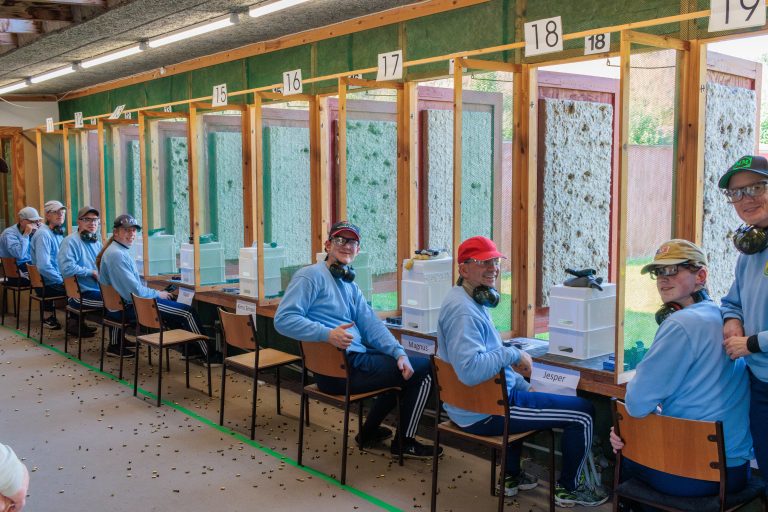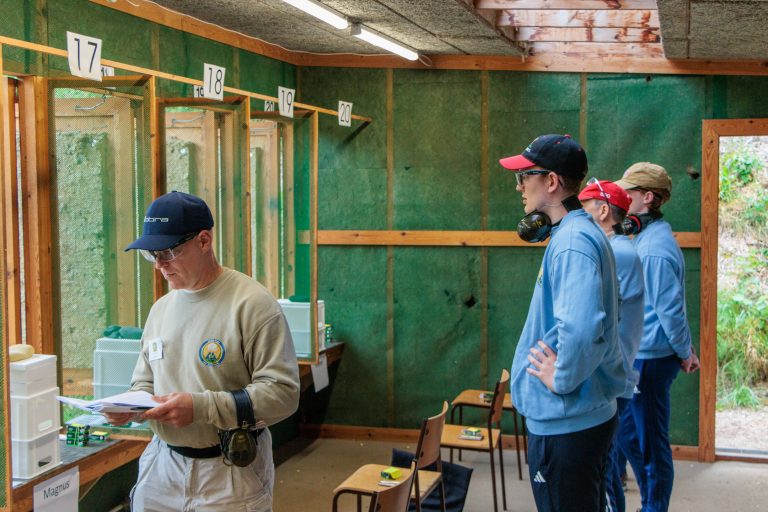
By Magnus Wulff Breinstrup, SDKSkyt, Ballerup
For most of us, there is a lot we don't know about ourselves and the challenge is that in order to improve, we first have to get to know ourselves, and POMW is a very effective tool to get to know ourselves .
Through the first POMW course, we were introduced to shooting - both the history behind it and the technique we had to use through training with airguns. To begin with, everyone was very uncomfortable with a gun - even if it was just an airgun - and most of us had a hard time seeing the targets when focusing on the sights. But as we trained both dry training and shooting with an airgun, we clearly became more comfortable with the firearm.
However, there was still a big difference between an airgun and a real gun, which we discovered on the second POMW course where we shot with a 0.22 caliber gun – first at a distance of 15 meters, and later at a distance of 25 meters. The biggest difference was in the form of the recoil, which highlighted the mistakes you had in your shooting technique. And if that wasn't enough, at the end of POMW II we were also allowed to try shooting with a 9mm pistol, where the recoil is much greater.
By comparison, recoil on the .22 caliber—which felt like a lot to begin with—was virtually non-existent. The big bang and violent recoil was extremely scary to begin with, but you had to get used to it.
At POMW III, however, we really started to become good marksmen. As part of our marksmanship training, we had to build a structure from home that we could use to rest the gun on while we shot. The support was a good tool to eliminate the biggest mistake – the commute. Without the commuting, it became much clearer to see what other mistakes you made during your shooting.
But on the first day of the course, it became very clear to me that my dry training at home had not been optimal, when, just like in POMW I & II, I started by shooting at the wrong target target - i.e. my partner's target 😊, despite the fact that there was taken measures to avoid it and I had received a warning about it. I simply couldn't tell the difference between the discs when they were 25 meters away. And that ruined it for both me and my mate - whose target I had accidentally shot at. So right from the start I felt a lot of pressure and through that I started to learn something about myself.
Throughout the course we alternated between shooting with and without supporting the gun to eliminate the commute. This meant that you had a good opportunity to learn what mistakes you made and improve them. To start with, we only shot with 0.22 caliber, as it had been summer vacation and it had been a long time since we had last shot, but later we were of course also allowed to shoot with 9 mm. Again, the greater recoil and the big bang were clearly noticeable.
We first shot at 25 meters with a pistol rest, to start getting used to the recoil, and there we just shot a lot of shots. Later we moved out onto the open grass to get closer to the target, where we shot without gun support.
Out on the open grass, there were no walls between us and our side mates, so you were much more affected by their shots, and you were also sometimes hit by their cartridge cases. I had Kimu Sensei on my left and he shoots extremely fast. Some might think it was the downer, as you could feel far more shots than if you were standing next to others, but I myself was deeply grateful for it. I was very afraid of the bang and the recoil of the 9mm pistol, and it was a hard process trying to make friends with it.
But when Kimu Sensei was standing next to me and firing off a bunch of shots, the bang suddenly became just background noise, and it showed in my shooting. It also had the effect that when Kimu Sensei stopped shooting, my fear of the bang from my own gun slowly began to return, but then I also had the opportunity to work with it.
While the instructors were shooting, I and 2 others had been given the task of loading up for Kimu Sensei. And there you really got a feel for how quickly you can shoot when you have control of the process. Despite being 3 to load Kimu Sensei's 5 magazines with room for 20 rounds each, Kimu Sensei still had to slow down his rate of fire so we could keep up. We loaded around 1000 rounds in total, and it could also be both seen and felt on the fingers afterwards.
Throughout the course, it could be seen from my results that I was generally not fully focused, and this was especially evident on the last day of the course. The lack of focus was also present in the dry training at home, and for that reason my final result was not as good as I had hoped for.
I had a lack of grounding during the course, and I simply couldn't figure out why - which probably makes sense, because if I could sense what problems I had, I would also have grounding.
But, despite the fact that POMW is a shooting course, it is first and foremost a tool for getting to know yourself, and I used it as that. The things I was told and discovered during the course is something I could definitely use to teach myself, and even as I write this article - a week after the last shooting and 2 weeks after the last POMW class from Kimu Sensei - I continue to learn more about myself through the toolbox called POMW.















